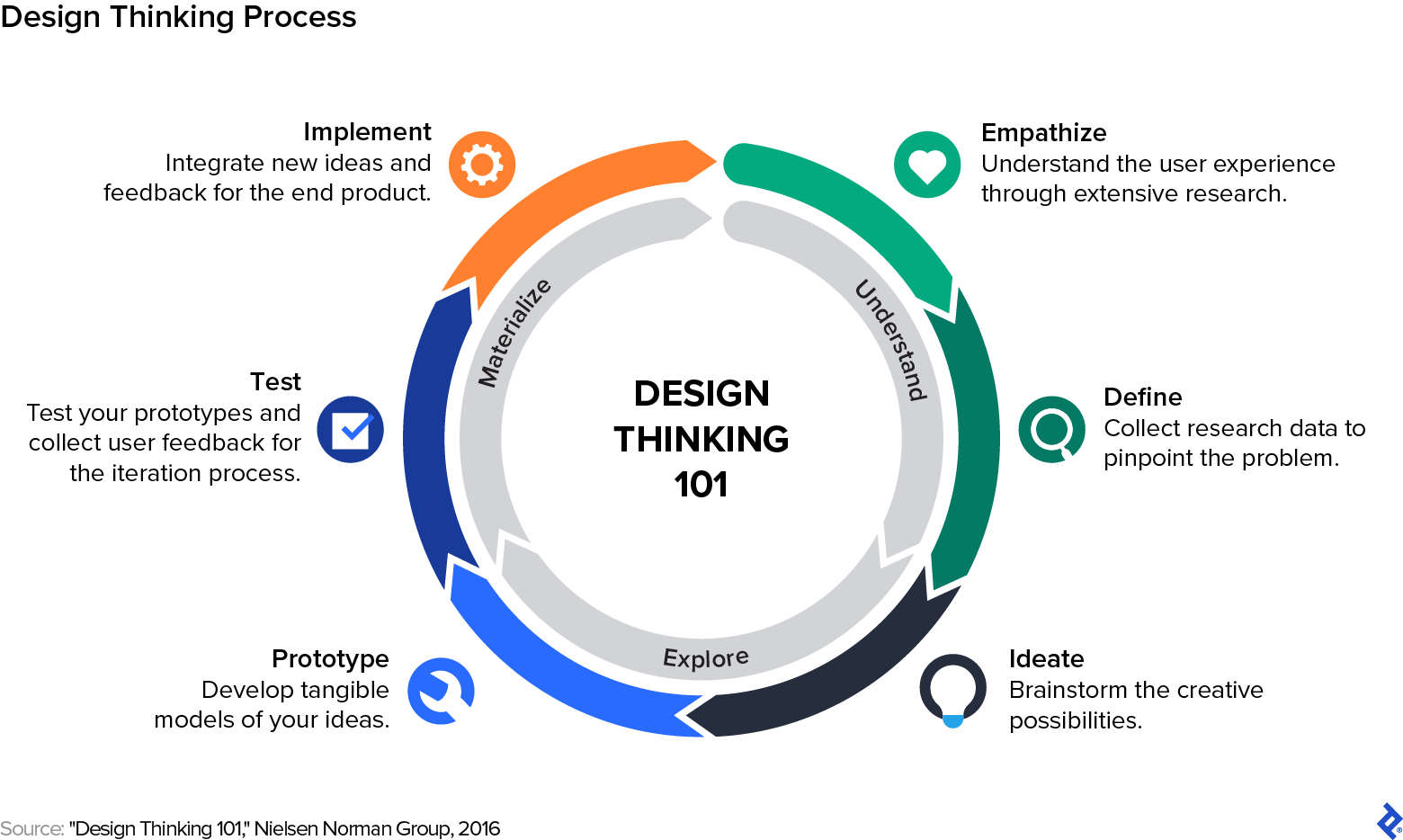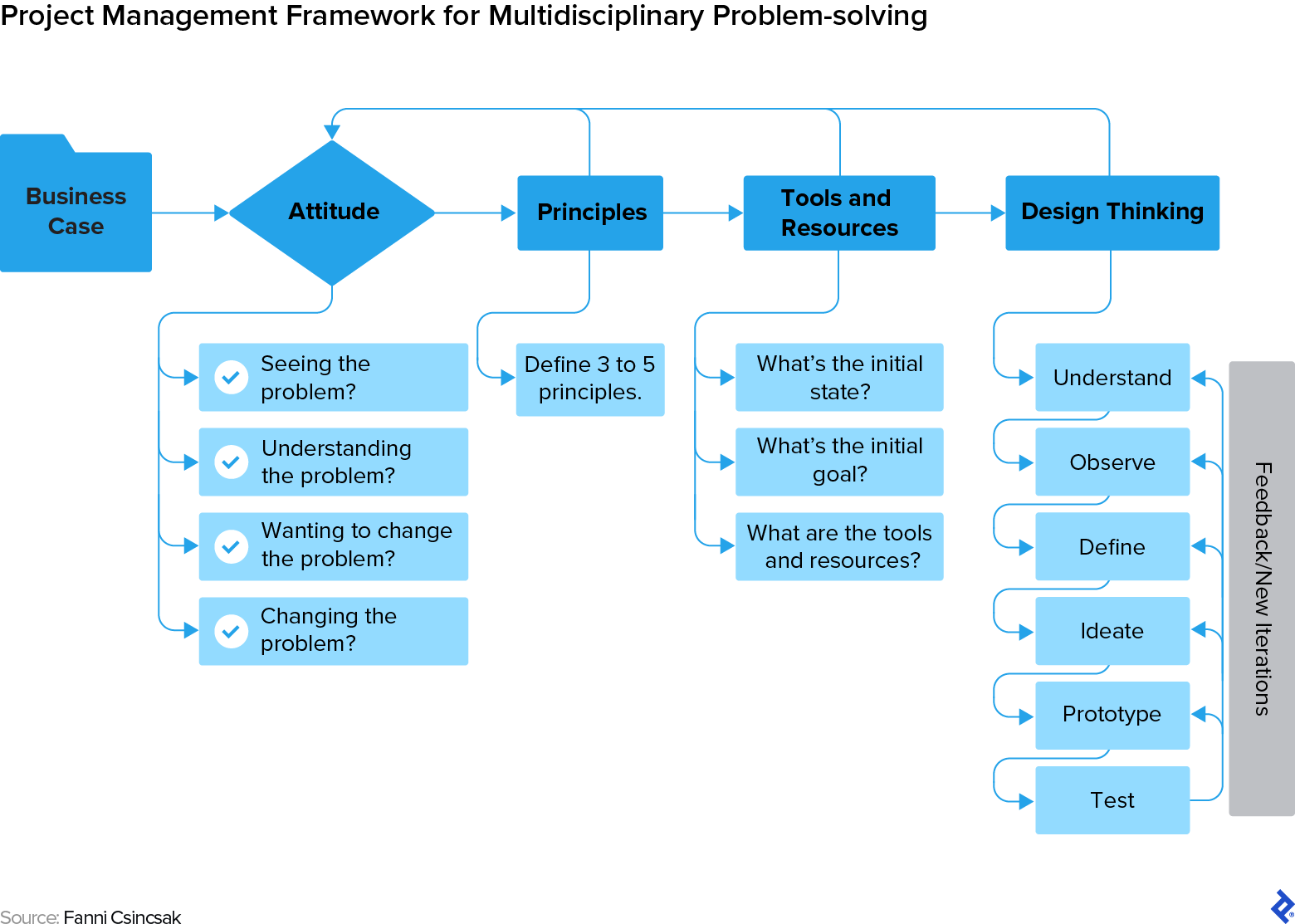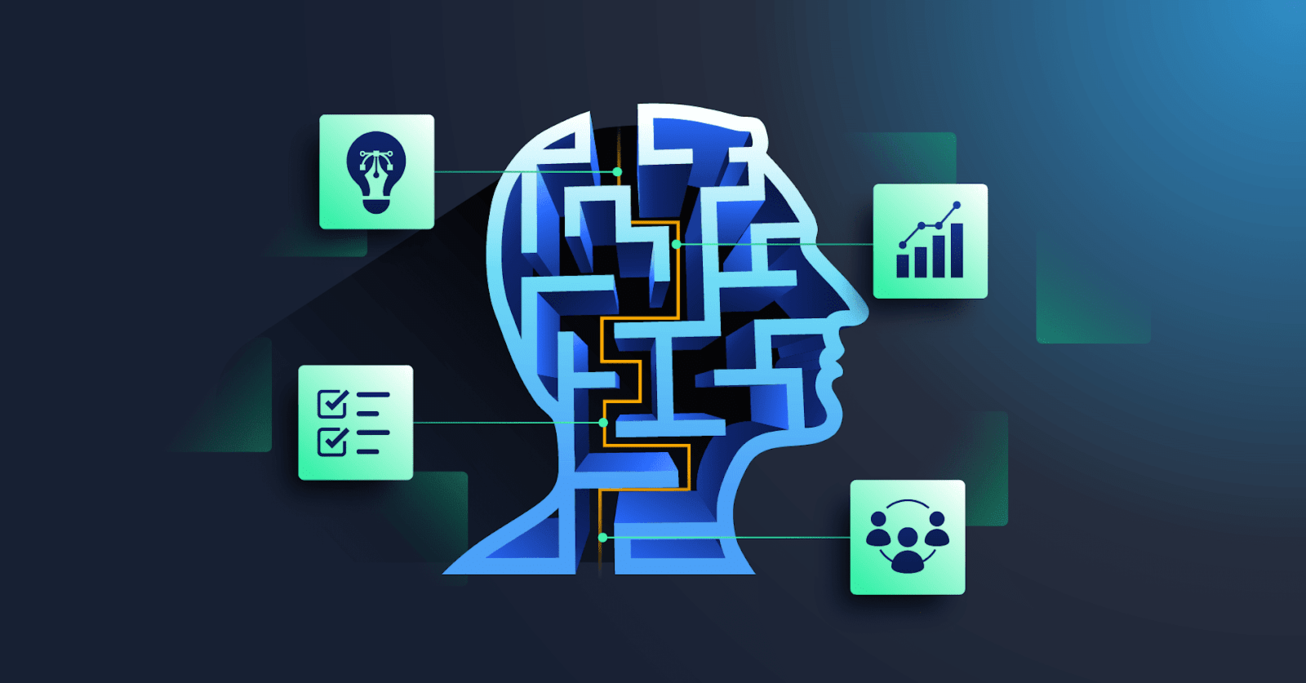How Thinking Like a Designer Can Help Solve Complex Business Problems
Unclear expectations, stakeholder disagreements, and conflicting interests can lead to inferior products and unhappy customers. Apply design thinking concepts to your next project to boost alignment and success.
Unclear expectations, stakeholder disagreements, and conflicting interests can lead to inferior products and unhappy customers. Apply design thinking concepts to your next project to boost alignment and success.
Fanni is a lead product designer who works with finance, e-commerce, and software companies. With a master’s degree in cognitive neuroscience and a PhD in human-computer interaction, Fanni understands how design thinking can help solve problems within a range of industries. She has collaborated with clients such as Canua and AltaML.
PREVIOUSLY AT


Consider this: A company wants to launch a mobile app, but its designers, developers, and marketing specialists disagree on which features to prioritize and how to market the product to users. In addition, the company’s budget for the project is tight and executives want to ship the app fast. How can the design team overcome collaboration barriers, meet the C-suite’s expectations, and deliver an app that is user-friendly and profitable?
This all-too-familiar example illustrates a complex problem with layered variables and conflicting interests that aren’t easy to reconcile. As a designer, I’ve experienced siloed teams and ineffective project management that caused stakeholders to have inconsistent expectations and information. Such scenarios are frustrating for everyone involved, but I’ve found that design thinking—a problem-solving approach valued by various industries—can bring clarity and resolution.
Design thinking starts with defining the problem space—a process that helps you determine if you’re solving the right problem for the right people. Problem spaces can be identified by three components:
- The initial state: This component represents the problem’s starting point, such as conflicting expectations and limited resources.
- The operators: These are the people capable of modifying a problem space, such as designers, developers, and marketing specialists.
- The test: The operators ideate possible solutions by collecting observations, assessing expectations, and empathizing with users. For example, is it financially possible to balance stakeholder and user needs with a product’s profitability?
This article will focus on how to use strategic design to address the problem space’s third component—the test—by using the design thinking framework, a multidisciplinary approach, data visualization, and project management systems.
Utilize the Design Thinking Framework
Design thinking is used in a variety of fields, including healthcare, e-commerce, and the entertainment industry. It helps multidisciplinary teams accurately define problems and find optimal solutions. Most frameworks contain five stages in the design thinking process, but the Nielsen Norman Group includes six. The stages are:
- Empathize: Design thinking starts by casting aside any assumptions you may have about the project and instead seeking to understand how others view the problem. You and your team can do this by observing users, collecting stakeholder perspectives, analyzing existing data, and identifying knowledge gaps on your team, among other activities. By the end of this stage, you will all recognize patterns in user behavior and connections between conflicting expectations.
- Define: Analyze your observations from stage 1 and synthesize the learnings into a problem statement. Your team can also start developing user personas to help guide design decisions in a user-friendly direction.
- Ideate: Leverage your design creativity to generate a range of potential solutions based on the findings from the previous two stages. Some of my favorite ideation methods include brainstorming, mind mapping, and scenario mapping. During the ideation phase, it’s important to focus on quantity over quality. The more ideas the better.
- Prototype: Select two to three ideas from the ideation stage and make them into a tangible product. By visualizing a potential design, your team will have an idea of what the product may look like and also be able to identify potential UX issues before testing.
- Test: Conduct prototype tests with potential customers. Document their feedback and highlight improvements that can be addressed in the next iteration.
- Implement: Integrate the feedback from user testing to improve the product for users. Due to the cyclical nature of design thinking, use empathy to understand user responses and how they can enhance the product.

When I worked on an automated investment tool for the financial services firm Canua, we applied design thinking to retain our American expatriate consumer base. Customers seemed to be having difficulty navigating the platform and completing documentation, especially the Report of Foreign Bank and Financial Accounts (FBAR). Our research found that users felt discouraged about the time and energy they spent filling out forms. We ideated possible solutions and agreed on an inexpensive way of automating the documentation process. After testing and implementation, we found that we had trimmed the documentation process down from an hour to five minutes, much to the delight of our users.
It’s worth mentioning that successful design isn’t always so linear. Design is a process of iteration, and failing is a step in the process. Design thinking isn’t a checklist for verifying your preferred solution; rather, it’s a process in which you should be ruthless about identifying problems in the design. Addressing shortcomings during the design phase is much less expensive than launching a problem-riddled product and recalling it later.
Approach Problems With Multiple Experts
A multidisciplinary approach can help transform conflicting goals into a collaborative environment. By integrating feedback and input from professionals in diverse fields, you will be able to analyze problems from multiple angles and ensure a comprehensive solution.
When I worked for the Budapest University of Technology and Economics, I was asked to lead a project to redesign the school’s faculty landing page to appeal to prospective students. Early in the project, I encountered competing interests and struggled to devise a design strategy that would address the needs of everyone involved. I knew a multidisciplinary approach would be key to overcoming this obstacle, so I brought together a diverse team, including the department head, communication specialists, developers, and current students. Each person brought a unique perspective and skill set to the table. Our communication specialists and students helped us understand the specific preferences of our target demographic. The developers ensured that our design ideas were feasible. The department head highlighted key academic information.
In the end, this collaboration led to a visually appealing landing page that effectively conveyed the faculty’s core values and experiences. By tapping into collective expertise, we created a page that resonated with our audience, resulting in increased applications and a more engaging online experience.
Cooperation among disciplines can be difficult to achieve and can add to the complexity of the problem. To aid collaboration, define project principles and goals at the outset as a group. Doing this ensures that everyone is on the same page and has a shared vision for moving forward when conflict arises. The earlier that common goals are established, the smoother the decision-making process will be.
Visualize All of the Information
Design thinking is a process that often yields complications, findings, and abstract ideas. When faced with this complexity, visualization is an effective way to organize and simplify information and create problem-solving consensus within the team.
For instance, when I managed the product team for a technology startup, we realized a communication barrier between the design and engineering departments was hindering our product. Both departments had valuable data but they had opted not to share it because they assumed the information was too complex. We hosted a meeting in a collaborative Miro board to solve this conflict. The developers built flowcharts, and the designers added user insights and personas. Within 15 minutes, we had co-created a model illustrating the product’s most important data and experiences. This simple visualization exercise helped us achieve an alignment that had been eluding us for weeks, and the departments decided to have an “Info Flow” meeting every other week to exchange critical data.
Designers are especially well equipped for visualization because many of our visual activities and artifacts naturally promote group visualization exercises. For example, you can create a mind map to visualize your project’s central problem and issues connected to it. Or you could develop a stakeholder map to help identify the people most affected by the problem. You can also create user personas, empathy maps, and journey maps to synthesize important user insights. Whatever techniques you choose, visualization facilitates understanding and makes communication between departments more efficient and effective.
Follow a Customized Project Management Framework
While a design thinking framework structures design activities, a project management framework guides product execution. When I worked on a digital product for a company operating in food delivery and passenger transport, the designers were separated from the developers—there was no direct communication between the teams. Worse, designers couldn’t directly access user insights and had to rely on their managers to relay these insights from senior executives, which led to frequent delays in the project timeline.
The management team used a Waterfall approach in which sequential phases organized product development into a linear process. To keep costs low, management sought to minimize the time it took to complete each stage of the process. This meant that designers weren’t able to explore user behavior, examine business needs, or validate solutions, and developers couldn’t create prototypes, resulting in an error-ridden product— users were unable to log in or complete payments. Additionally, there were no performance reviews or opportunities for design feedback. Motivation on the team waned, as did user engagement. The company’s project management framework determined our team’s operation—making development and product success nearly impossible.

Project management frameworks can help solve complex problems and push production along, but they need the nonlinear attributes found in design thinking, a process that saves time and money by enabling continuous iteration early in the product development process.
Another strategy is the minimum viable product (MVP) process, in which product teams launch a product that addresses basic user problems with limited features. They then collect user feedback to refine the product. An MVP enables rapid prototyping and continuous improvement. Using an MVP process prevents designers from making assumptions about what users need and assists them when they might be wasting resources by going in the wrong direction.
Project management frameworks promote collaboration, innovation, and customer engagement, leading to more effective problem resolution and alignment with real-world needs.
Problems Solved by Design Thinking
At the beginning of my career, I worked on an online gambling platform. We used a Lean system to reduce production time, but it didn’t allow for user feedback. After we released the product, we still needed to solve an ethical dilemma: A substantial portion of our active users were struggling with gambling addiction. To address this problem, we conducted extensive research on gambling addiction and in-depth interviews with users, and then set out to redesign our platform with a new goal: to create a digital environment where users could enjoy gambling as a form of entertainment, not as a destructive habit.
Our team applied design thinking to this problem and created a product that better met consumer needs and aligned with our new goal. We created self-exclusion tools that allowed users to voluntarily restrict their access to the platform for a predetermined period. We implemented strict deposit and betting limits, along with pop-up warnings that reminded users to bet responsibly. Our team also provided easy access to information and links to support organizations and helplines for individuals seeking help for gambling addiction. To address such a sensitive topic, our team had to agree on values that paved the way for a successful redesign.
Problem-solving and company culture are pivotal drivers for organizational success, according to McKinsey & Company. As organizations embrace traits like open communication, vulnerability, trust, and skill development, they cultivate an environment conducive to the iterative and collaborative nature of the design thinking framework. This environment, influenced by the essence of design thinking, enables teams to collectively tackle challenges, fostering a landscape of continuous innovation and adaptability.
In the production process, it can seem as if problem-solving is a problem in itself. But strategic design thinking provides structure, the opportunity for iteration, and a user-centered approach that equips teams to tackle a variety of complex problems. Multidisciplinary approaches, visualization tools, and project management frameworks enhance design thinking and the problem-solving journey, giving teams the tools to design their own solutions.
Further Reading on the Toptal Blog:
Understanding the basics
How do you apply design thinking?
Design thinking is an iterative process that enables creative solutions. It can be applied to a range of business problems, from product design to business strategy. Start with defining the problem, then ideate solutions, prototype the ideas, test them with users, and collect feedback for iterations.
What is an example of a design thinking problem?
An example of a design thinking problem would be redesigning the user experience of a mobile app. Designers should collect user feedback to understand pain points, then apply the feedback in the iteration process. Test the redesigned app to see if the improvements addressed user needs.
Why is design thinking useful for problem-solving?
Because of its iterative nature, design thinking implements a user-centered approach that helps give designers a deeper understanding of a user’s issues. The iterations allow for quick changes to the product, gradually reaching the optimal solution.
About the author
Fanni is a lead product designer who works with finance, e-commerce, and software companies. With a master’s degree in cognitive neuroscience and a PhD in human-computer interaction, Fanni understands how design thinking can help solve problems within a range of industries. She has collaborated with clients such as Canua and AltaML.
PREVIOUSLY AT



